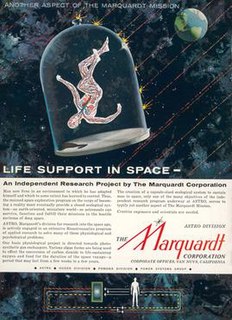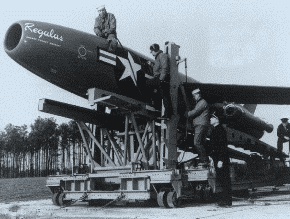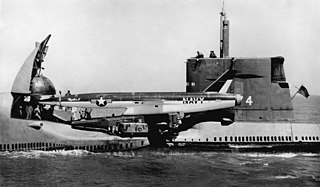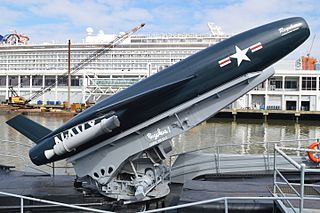
The UGM-27 Polaris missile was a two-stage solid-fueled nuclear-armed submarine-launched ballistic missile. The United States Navy's first SLBM, it served from 1961 to 1996.

41 for Freedom refers to the US Navy Fleet Ballistic Missile (FBM) submarines from the George Washington, Ethan Allen, Lafayette, James Madison, and Benjamin Franklin classes. All of these submarines were commissioned 1959-1967, as the goal was to create a credible, survivable sea-based deterrent as quickly as possible. These submarines were nicknamed "41 for Freedom" once the goal of 41 nuclear-powered ballistic missile submarines (SSBNs) was established in the early 1960s. The 1972 SALT I Treaty limited the number of American submarine-launched ballistic missile tubes to 656, based on the total missile tubes of the forty-one submarines, in line with the treaty's goal of limiting strategic nuclear weapons to the number already existing.

Hawaii (CB-3) was intended to be the third member of the Alaska-class large cruisers. It was the first United States Navy ship to be named after the-then Territory of Hawaii. Because Hawaii's construction was delayed by higher-priority ships like aircraft carriers, its keel was not laid until December 1943, about two years after its sister ship Guam.

USS Grayback (SS/SSG/APSS/LPSS-574), the lead ship of her class of submarine, was the second ship of the United States Navy to be named for the grayback.
A cruise missile submarine is a submarine that launches cruise missiles (SLCMs) as its primary armament. Cruise missile and dedicated anti-ship missiles greatly enhance a vessel's ability to attack surface combatants. Torpedoes are a more stealthy option, but missiles give a much longer stand-off range, as well as the ability to engage multiple targets on different headings at the same time. Many cruise missile submarines retain the capability to deploy nuclear warheads on their missiles, but they are considered distinct from ballistic missile submarines due to the substantial differences between the two weapons systems' characteristics.

Marquardt Corporation was one of the few aeronautical engineering firms that was dedicated almost solely to the development of the ramjet engine. Marquardt designs were developed through the 1940s into the 1960s, but the ramjet never became a major design and the company turned to other fields in the 1970s. They suffered a particularly bad financial crisis with the ending of the Cold War, and went bankrupt in the 1990s.

The North American SM-64 Navaho was a supersonic intercontinental cruise missile project built by North American Aviation (NAA). The final design was capable of delivering a nuclear weapon to the USSR from bases in the US, while cruising at Mach 3 at 60,000 feet (18,000 m) altitude. The missile is named after the Navajo Nation.

Rocket mail is the delivery of mail by rocket or missile. The rocket lands by deploying an internal parachute upon arrival. It has been attempted by various organizations in many different countries, with varying levels of success. It has never become widely seen as being a viable option for delivering mail, due to the cost of the schemes and numerous failures.
The Burya was a supersonic, intercontinental cruise missile, developed by the Lavochkin design bureau under designation La-350 from 1954 until the program cancellation in February 1960. The request for proposal issued by the Soviet government in 1954, called for a cruise missile capable of delivering a nuclear payload to the United States. Analogous developments in the United States were the SM-62 Snark and SM-64 Navaho cruise missiles, particularly the latter, which used parallel technology and had similar performance goals.

The C-301 is a large supersonic coastal defense anti-ship missile (AShM), and it is the basis on which two other members of the C-300 series AShM C-302 and C-303 developed from.

The Hermes project was started in response to Germany's rocket attacks in Europe. Project Hermes was to determine the missile needs of army field forces. "Accordingly the Ordnance Department entered into a research and development contract with the General Electric Company on 20 November 1944. "This contract authorized the General Electric Company to seek the development of long-range missiles that could be used against both ground targets and high-altitude aircraft. The contractor agreed to perform investigations, research, experiments, design, development, and engineering work in connection with the development of long-range missiles for use against ground targets and high-altitude aircraft." General Electric was also to investigate ramjets, solid rocket motors, liquid propellant rocket engines, and hybrid propellants. "The contract also required the General Electric Company to develop remote control equipment, ground equipment, fire control devices, and homing devices."

The Grayback-class submarine was a class of two guided missile carrying submarines of the United States Navy. They carried the Regulus I and Regulus II nuclear cruise missiles, deployed 1957–64, that were phased out by Polaris Submarine Launched Ballistic Missiles (SLBMs). They and USS Halibut were the sole submarines designed specifically to carry Regulus missiles, and the only submarines capable of carrying Regulus II. However, USS Tunny and USS Barbero were modified earlier to carry two Regulus I missiles per boat.

The SSM-N-9 Regulus II cruise missile is a supersonic guided missile armed with a nuclear warhead, intended for launching from surface ships and submarines of the U.S. Navy (USN).

The Advanced Strategic Air-Launched Missile (ASALM) was a medium-range strategic missile program, developed in the late 1970s for the United States Air Force. Intended for use in both the air-to-surface and anti-AWACS roles, the missile's development reached the stage of propulsion-system tests before being cancelled in 1980.

The Creative Research On Weapons or Crow program was an experimental missile project developed by the United States Navy's Naval Air Missile Test Center during the late 1950s. Intended to evaluate the solid-fueled integral rocket/ramjet (SFIRR) method of propulsion as well as solid-fueled ramjet engines, flight tests were conducted during the early 1960s with mixed success.

The AAM-N-5 Meteor was an early American air-to-air missile, developed by the Massachusetts Institute of Technology and Bell Aircraft for the United States Navy. Designed for launch from carrier-based aircraft, the program proceeded to the flight testing stage before being cancelled.
The SSM-N-2 Triton was a supersonic nuclear land-attack cruise missile project for the United States Navy. It was in development from 1946 to 1957, but probably no prototypes were produced or tested. The Triton program was approved in September 1946, designated SSM-2 a year later, and redesignated SSM-N-2 in early 1948. A preliminary design was produced by 1950 as the XSSM-N-2, but was scaled down by 1955 and redesigned again in 1957. Triton was cancelled in 1957, probably as a result of the 1956 decision to focus the Navy's strategic weapons development on the Polaris submarine-launched ballistic missile. In any case, prototypes of the similar Regulus II missile had already flown, and Triton was redundant, offering only an increase in range from 1,000 nautical miles (1,900 km) to 1,500 nautical miles (2,800 km), which Polaris was about to achieve along with many other advantages. Regulus II was itself cancelled in 1958, although testing of missiles already built continued for several years.

















